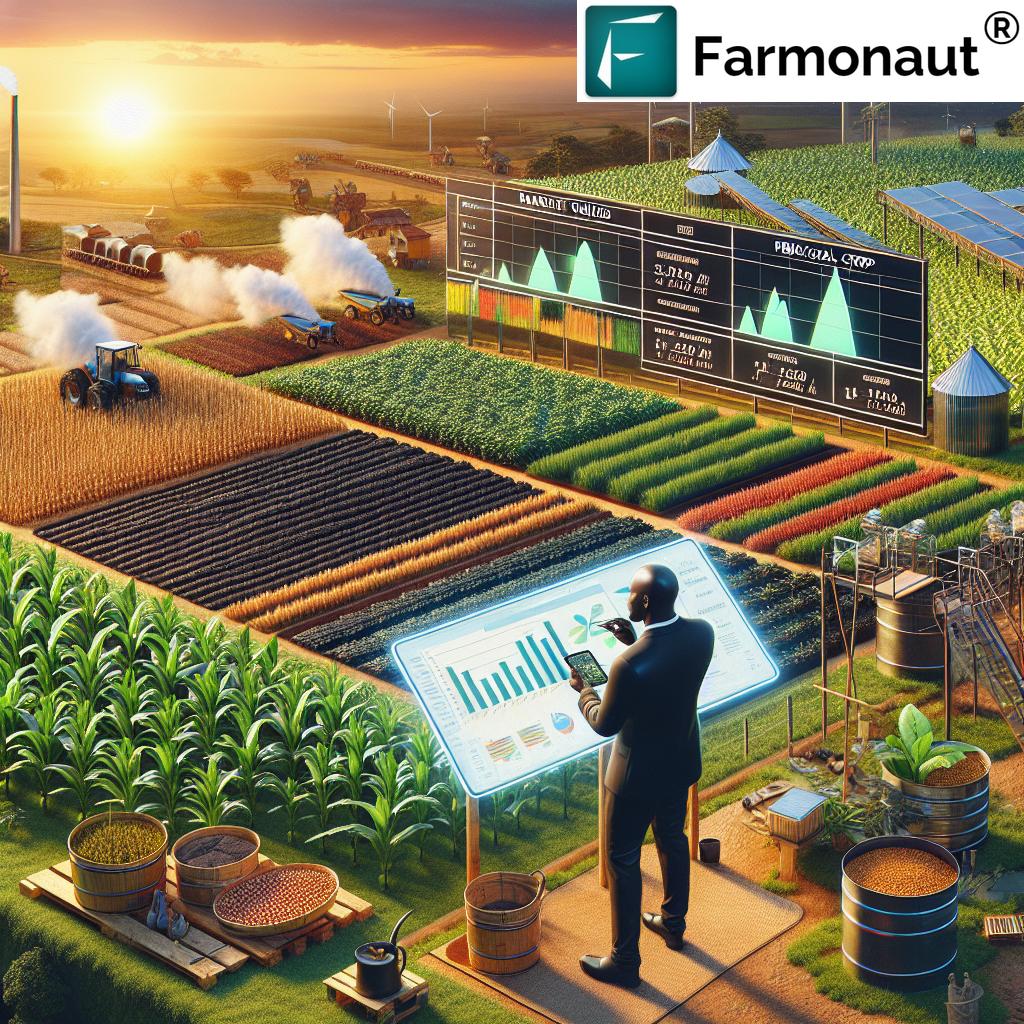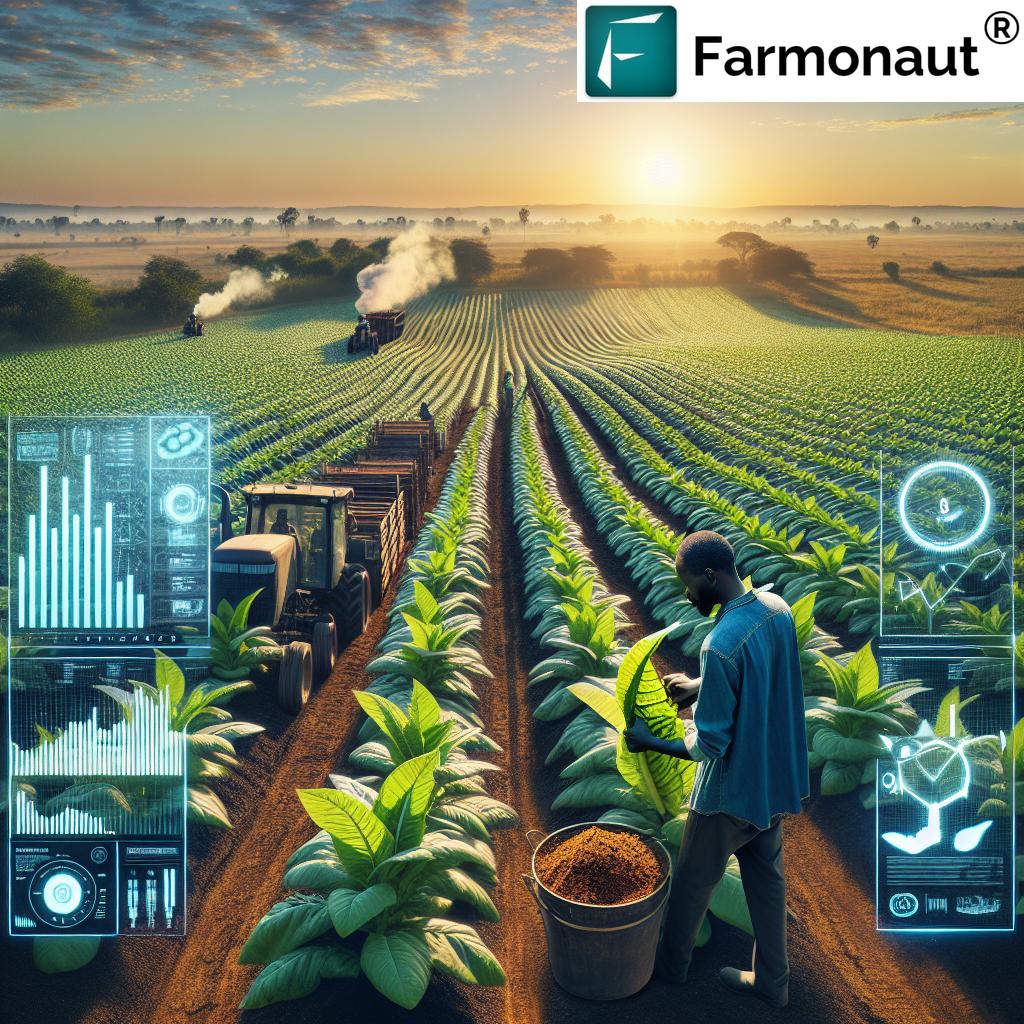Challenges Facing Dairy Farming in Kenya: 2025 Tactics
“Smallholders produce over 80% of Kenya’s milk; weak cooling chains can waste 10–20% on hot days.”
Kenya’s dairy farming remains a cornerstone of the agricultural economy, providing livelihoods to millions and supplying a growing domestic market. In 2025, the sector faces intensified pressures from climate variability, rising input costs, weak value chains, disease threats, and a struggle to attract and retain youth. This article examines the challenges facing dairy farming in Kenya in 2025 and outlines practical pathways forward to improve milk quality, sector resilience, and inclusive growth for rural communities.
Table of Contents
- Executive Summary — Challenges Facing Dairy Farming in Kenya in 2025
- Kenya’s Dairy Sector in 2025: Context and Momentum
- Core Challenges Facing Dairy Farming in Kenya
- Pathways Forward: 2025 Tactics to Improve Milk Quality and Resilience
- Digital and Data Enablers for Dairy in Kenya (Farmonaut)
- Challenge‑to‑Tactic Impact‑Cost Matrix (Kenya, 2025)
- Implementation Roadmap 2025–2027
- FAQs
Executive Summary — Challenges Facing Dairy Farming in Kenya in 2025
By 2025, the challenges facing dairy farming in Kenya have sharpened. Climate variability brings more frequent droughts and erratic rainfall linked to changing El Niño/La Niña cycles, reducing pasture availability and water access. Feed prices have surged due to global fertilizer and grain cost volatility, forcing many farmers to rely on low-quality substitutes that depress milk yields. Endemic and emerging diseases — mastitis, lumpy skin disease, foot-and-mouth, and tick-borne infections — continue to undermine productivity. Weak chains across the value chain increase milk spoilage, reduce quality, and destabilize prices. Informal markets remain dominant, complicating compliance with formal standards and depressing value for producers.
Infrastructure and logistics constraints — rural roads, electricity, and cold transport — limit reliable cooling and value addition (cheese, yogurt, ghee). Access to finance remains a critical bottleneck as many smallholders lack collateral and predictable cash flows, restricting investment in improved breeds, housing, milking machines, and renewable energy systems. The sector faces a youth challenge too: limited land, capital, training, and modern technology make farming appear risky and low-status. Fragmented extension services, inconsistent policy incentives, and weak enforcement of quality standards further slow change.
Yet, 2025 also offers pathways forward. Strengthening cooperatives and farmer organizations can reduce transaction costs, improve bargaining power, and make cooling and value addition viable. Decentralized solar cooling, improved forage varieties, and water-harvesting systems can reduce climate risk. Affordable digital services — mobile finance, market platforms, and tele‑veterinary support — can attract youth and improve efficiency. Public‑private efforts can scale vaccinations, artificial insemination (AI) services, and quality‑assured milk collection. Targeted youth-friendly finance, land-access reforms, and vocational training will be essential to secure long-term sector vitality. Taken together, these actions can improve milk quality, raise yields, and build resilience.
Kenya’s Dairy Sector in 2025: Context and Momentum
Kenya’s dairy sector remains a cornerstone of the agricultural economy, providing livelihoods and employment across rural counties such as Kiambu, Nyandarua, Nakuru, Uasin Gishu, Meru, and Nyeri, among others. The sector is vital for food security, inclusive growth, and a growing domestic market. Smallholders produce the majority of milk, and they rely on timely access to inputs, reliable market services, and predictable prices.
In 2025, the sector faces intensified pressures: climate variability, rising input costs, and disease threats. However, there is momentum in climate‑smart practices, decentralized cooling, and digitization. Mobile-based credit, digital advisory, and improved extension services are expanding. Investments in rural power systems, solar energy, and localized cold chains are emerging solutions to reduce post-harvest losses. If coordinated well, these innovations can improve value and quality while reducing risk and costs.
Core Challenges Facing Dairy Farming in Kenya
1) Climate and Feed Insecurity
Climate variability, frequent droughts, and erratic rainfall — linked to changing El Niño/La Niña cycles — reduce pasture availability and water. Seasonal shocks in arid and semi-arid lands (ASALs), as well as in traditionally high-output counties, strain forage conservation capacity. Without reliable irrigation and water harvesting, many smallholders remain exposed to seasonal shocks. Feed prices have surged due to global fertilizer and grain cost volatility, forcing farmers to reduce herd sizes or rely on low‑quality substitutes that depress yields and animal health. These dynamics contribute to persistent feed insecurity.
Simple, low‑cost measures can reduce risk: planting drought‑tolerant fodder grasses (e.g., Brachiaria), integrating legumes, mulching, and scheduling irrigation based on field moisture. Investments in water pans, roof rainwater harvesting, and drip systems help stabilize dry‑season feed. Seasonally adjusted feeding plans (e.g., higher‑energy evening feeds during hot spells) can maintain milk flow through heat waves.
2) Animal Health, Breeding, and Services
Endemic and emerging diseases — including mastitis, lumpy skin disease, foot‑and‑mouth disease (FMD), and tick‑borne infections — continue to undermine productivity. Veterinary services are unevenly distributed; diagnostics, vaccines, and timely treatments are often unaffordable or inaccessible for smallholders. Genetic improvement programs are hampered by poor record‑keeping and fragmented artificial insemination services, resulting in inconsistent gains in milk yield and resilience.
These disease threats frequently increase costs and cause yield losses. Mastitis alone can reduce milk output, degrade quality (high somatic cell counts), and trigger rejected milk at collection points. Without consistent breeding records and heat detection, AI timing suffers, lengthening calving intervals and depressing overall farm profitability. Better herd health protocols, vaccination campaigns, and coordinated AI programs are needed to reduce risks.
3) Value Chain and Market Inefficiencies
Milk prices remain volatile. Smallholder farmers often face delayed payments, milk spoilage due to weak cold chains, and low margins driven by multiple intermediaries. Informal markets dominate in many areas, complicating compliance with food safety and quality standards required by formal processors and any potential export markets. Adulteration and inconsistent quality reduce consumer confidence and impede sector development. These value-chain gaps limit the full value capture for farmers and challenge formalization efforts.
4) Infrastructure, Cooling, and Logistics
Insufficient rural roads, unreliable electricity, and limited refrigerated transport undermine milk collection and processing. Weak, fragmented cooling systems increase spoilage and reduce milk quality. On hot days, poor cooling chains can waste 10–20% of produced milk. Without reliable power, value addition such as pasteurization, yogurt, cheese, or long-life products remains limited in many localities. Transport inefficiencies raise costs and reduce competitiveness for both formal and informal value chains.
5) Access to Finance, Inputs, and Energy
Many smallholders are excluded from formal credit due to lack of collateral, irregular incomes, and perceived risk. This limits investment in improved breeds, housing, milking equipment, renewable energy solutions for cooling, and irrigation. Subsidy programs are often poorly targeted or unsustainable. With input prices rising — feed, fertilizer, veterinary products — liquidity constraints can force short‑term choices that reduce long‑term productivity and resilience.
6) Youth Engagement and Labor
Among the challenges facing youth in agriculture are limited access to land, capital, modern training, and technology. Younger Kenyans often view farming as low‑status and risky, preferring urban jobs. Aging farmer demographics threaten long‑term vitality of dairy. Youth‑friendly finance, digital tools, and vocational training can make dairy more attractive, productive, and viable as a career.
7) Policy and Institutional Gaps
Fragmented extension services, weak enforcement of quality standards, and inconsistent policy incentives undermine coordinated sector development. Climate‑smart agriculture, disease surveillance, and data‑driven planning need stronger institutional backing and better coordination between county and national bodies. Transparent, predictable policies can unlock private investment and improve the reliability of formal markets.
“Heat stress can cut daily milk yields 10–25%; shade, water, and feed timing help recover output.”
Pathways Forward: 2025 Tactics to Improve Milk Quality and Resilience
Addressing the challenges facing agriculture in Kenya and, specifically, the challenges facing dairy farming requires a blend of climate resilience, value‑chain modernization, finance access, youth engagement, and coordinated policy action. The following 2025 tactics prioritize practical, cost‑effective steps with measurable outcomes.
A) Climate Resilience and Forage Systems
- Adopt drought‑tolerant forages and legumes to stabilize feed quantity and quality.
- Invest in rainwater harvesting, shallow boreholes where viable, and drip irrigation for fodder plots.
- Implement silage and haymaking calendars aligned to rainfall windows; promote community chaff cutters and shared balers.
- Use heat mitigation: midday shade, cool clean water, and feeding higher‑energy rations during evening to reduce heat stress.
B) Animal Health, Vaccination, and Breeding Improvements
- Scale county‑wide vaccination campaigns (FMD, lumpy skin) and routine deworming and tick control.
- Standardize mastitis control: pre/post‑milking hygiene, teat dips, and regular somatic cell count checks at collection points.
- Improve breeding through data: estrus detection aids, record‑keeping, and synchronized AI services to reduce calving intervals.
- Promote genetic improvement programs that balance milk yield and climate resilience, supported by performance recording.
C) Milk Quality and Food Safety
- Set and enforce clear quality standards at collection (temperature, antibiotic residue, adulteration checks).
- Expand decentralized cooling hubs with solar‑powered chillers near farm clusters to reduce travel time.
- Introduce pay‑for‑quality schemes (fat, protein, low SCC) to incentivize hygienic milking and proper storage.
- Train handlers on clean milk production, rapid cooling, and transport hygiene to reduce contamination.
D) Value-Chain Modernization and Cooperative Strengthening
- Strengthen cooperatives to aggregate volumes, negotiate better prices, and co‑finance cooling, pasteurizers, and testing kits.
- Deploy digital collection records and transparent payment systems to reduce delays and build farmer trust.
- Develop branded dairy products (yogurt, cultured milk) to improve margins and reduce reliance on bulk raw milk sales.
- Integrate traceability from farm to collection to processing to build consumer confidence and open formal markets.
E) Infrastructure, Cooling, and Logistics
- Invest in solar‑powered milk cooling tanks for village hubs; integrate with insulated cans and scheduled pick‑ups.
- Improve last‑mile roads around dairy clusters through public works and cooperative advocacy.
- Use route optimization to reduce fuel costs and transit times for milk collection vehicles.
F) Finance, Inputs, and Energy Access
- Expand input credit tied to milk deliveries with transparent terms and insurance for weather or disease shocks.
- Offer targeted, youth‑friendly loans for small equipment (milking machines, solar fridges, chaff cutters).
- Promote energy solutions: solar PV for cooling and lights; biogas for hot water and milking hygiene.
G) Youth Engagement, Skills, and Jobs
- Make dairy “tech‑forward”: digital advisory, mobile payments, AI heat detection, and e‑learning to attract youth.
- Develop vocational programs for paravets, AI technicians, milk testers, cold‑chain operators, and data officers.
- Facilitate land‑leasing and shared infrastructure models so youth can enter without large upfront costs.
H) Policy and Institutional Alignment
- Harmonize standards across counties for milk quality, testing, and enforcement.
- Coordinate extension so that vaccination, AI, and quality programs are synchronized with seasonal calendars.
- Use data to target support: drought‑early warnings, feed subsidy triggers, and disease surveillance alerts.
Digital and Data Enablers for Dairy in Kenya (Farmonaut)
Digital tools reduce costs, improve quality, and create new youth jobs. Below are ways satellite data, AI, and traceability can strengthen daily operations across the Kenyan dairy value chain. We remain mindful that Farmonaut is not an online marketplace, not a manufacturer or seller of farm inputs or machinery, and not a regulatory body. Our focus is providing satellite‑driven insights and data‑powered advisory tools that are affordable and accessible.
Satellite Monitoring and AI Advisory
We provide satellite‑based monitoring of vegetation and soil conditions to guide forage planning, irrigation timing, and drought response. With our AI advisory, dairy clusters can receive weather‑aligned recommendations that help reduce feed costs and stabilize milk yields. This supports climate resilience, a key need for the sector in 2025.
- Real‑time monitoring of fodder plots and pasture vigor helps plan harvesting, conserve forage, and reduce waste.
- Weather alerts can trigger preventive animal‑health actions (e.g., tick pressure, heat stress periods).
- Data integration supports cooperative managers to schedule milk collection around reliable cooling windows.
Blockchain‑Based Traceability and Quality
Traceability builds consumer trust and improves market access. Recording milk origin, temperature at collection, transport timelines, and test results on a tamper‑resistant ledger reduces adulteration risks and enhances transparency for formal markets. This aligns with 2025 goals to improve standards, quality, and value along the chain.
APIs and Integration for Cooperatives and Processors
We offer APIs so cooperatives, processors, and solution providers can embed satellite and advisory data into their systems, improving logistics, cooling operations, and quality tracking. This reduces fragmentation across weak chains by enabling coordinated, data‑driven decisions from farm to market.
Farmonaut API — integrate satellite insights for forage, moisture, and weather into your dairy management system.
Developer Docs — see how to authenticate, pull layers, and route data to dashboards for collection hubs and transport teams.
Product Links for Dairy Use Cases
- Traceability — Build consumer trust in milk by recording quality checks, temperatures, and collection routes. Traceability can reduce adulteration, enhance standards compliance, and increase value in formal markets.
- Carbon Footprinting — Track environmental impact of dairy operations (manure management, energy, fodder systems). This supports sustainability goals, potential incentives, and informed investment in improved energy systems.
- Fleet Management — Optimize milk collection routes and vehicle utilization. Reduce costs, improve timing to cooling tanks, and maintain milk quality with data‑driven logistics.
- Crop Loan & Insurance Verification — Satellite‑based verification can support financial institutions in assessing risk and improving access to finance for forage plots and water infrastructure, enhancing smallholder resilience.
- Large‑Scale Farm Management — For cooperatives and aggregators, manage multiple dairy clusters, track field conditions, and coordinate extension and quality programs across regions.
- Advisory Access — Access our platform and advisory tools to monitor fields, plan fodder, and align actions with weather windows.
Challenge‑to‑Tactic Impact‑Cost Matrix (Kenya, 2025)
Caption: Impact‑cost matrix for Kenya’s dairy sector (2025) — quickly compare actionable tactics to boost milk yield, reduce risk, and create youth jobs across value‑chain nodes. Regional context: Kenya (Kiambu, Nyandarua, Nakuru, Uasin Gishu, Meru, Nyeri, among others). All figures are indicative estimates for planning and prioritization.
| Challenge | 2025 Tactic | Estimated milk yield gain (%; 5–20%) | Estimated cost per cow (KES; 800–3,500) | Time to impact (months; 2–12) | Risk reduction score (1–5) | Adoption difficulty | Value‑chain node | Youth jobs potential (per 1,000 cows; 10–40) | Farmonaut support (advisory/remote sensing) |
|---|---|---|---|---|---|---|---|---|---|
| Climate variability | Drought‑tolerant forage + water harvesting + heat‑stress mitigation | 10–15% | 1,200–2,500 | 3–6 | 4 | Medium | Farm | 15–25 | Remote sensing for forage vigor; weather‑aligned advisory |
| Feed scarcity and price volatility | Silage/hay programs; community chaff cutters; feed calendars | 8–12% | 1,000–2,000 | 2–4 | 3 | Low–Medium | Farm/Collection | 10–20 | Advisory on harvest windows; pasture monitoring |
| Animal health (mastitis, ticks) | Vaccination + mastitis control kits + tick management | 12–18% | 1,500–3,000 | 3–6 | 5 | Medium | Farm/Collection | 20–30 | Advisory on risk windows (weather/tick pressure) |
| Low milk quality/contamination | Pay‑for‑quality + hygiene training + residue testing | 6–10% | 800–1,500 | 2–3 | 4 | Low | Collection/Processing | 10–15 | Advisory on cooling targets; traceability integration |
| Weak cold‑chain logistics | Solar chillers + insulated cans + route optimization | 7–12% | 2,000–3,500 | 4–8 | 4 | Medium | Collection/Processing | 15–25 | Advisory on pickup timing; fleet optimization insights |
| Limited finance/credit | Milk‑linked loans + insurance + digital scoring | 5–9% | 1,000–2,000 | 4–6 | 3 | Medium | Farm | 10–20 | Remote sensing verification; advisory to lenders |
| Genetics/AI service gaps | Record‑keeping + estrus detection + synchronized AI | 10–16% | 1,500–2,500 | 6–12 | 4 | Medium | Farm | 15–20 | Advisory on timing; weather‑based planning |
| Data and reporting gaps | Digital records for milk, health, feed, and payments | 5–8% | 800–1,200 | 2–4 | 3 | Low | Farm/Collection | 10–15 | Remote monitoring; advisory dashboards |
| Informal market dominance | Co‑op aggregation + traceability + pay‑for‑quality | 7–10% | 1,200–2,000 | 6–12 | 4 | Medium | Collection/Market | 20–40 | Traceability and advisory for formal market entry |
Implementation Roadmap 2025–2027
Coordinated action is essential. A phased approach can lower adoption difficulty, reduce risk, and create youth jobs while improving milk quality and market value.
Phase 1 (0–6 months): Stabilize Basics and Reduce Losses
- Roll out clean milk production training and mastitis control across clusters; install handwashing, teat dips, and basic testing at collection points.
- Establish cooperative governance for transparent payments, digital records, and quality-linked pricing.
- Set up initial solar cooling hubs in hot‑spot zones with weak electricity to reduce spoilage and improve quality.
- Launch weather‑aligned fodder calendars and begin rainwater harvesting where feasible.
Phase 2 (6–18 months): Build Capacity and Scale Quality
- Coordinate vaccination campaigns and tick control with county extension; digitize health records.
- Deploy route optimization and fleet management for milk collection; expand insulated can usage.
- Implement traceability from farm to collection to processing; start pay‑for‑quality premiums.
- Introduce youth vocational tracks: paravets, AI technicians, cold‑chain operators, data & traceability officers.
Phase 3 (18–36 months): Deepen Resilience and Add Value
- Scale drought‑tolerant forages, silage, and water infrastructure; integrate solar‑biogas hybrids for energy needs.
- Pilot value addition (yogurt, cheese) where quality and volumes are stable; expand formal market compliance.
- Strengthen policy alignment: harmonized standards, coordinated extension cycles, and data‑driven subsidy triggers.
For integrators and developers supporting cooperatives and processors, our API and API Docs enable seamless embedding of advisory and remote‑sensing layers into your own dashboards.
FAQs
What are the most urgent challenges facing dairy farming in Kenya in 2025?
The most urgent challenges are climate variability and feed insecurity; animal diseases (mastitis, lumpy skin disease, tick‑borne diseases); weak value chains and cooling systems; limited access to finance; and youth disengagement. These issues reduce milk yields, quality, and market value while raising costs and risks.
How can smallholders reduce losses from weak cold chains?
- Adopt solar‑powered cooling at village hubs and use insulated cans.
- Schedule milk collection to minimize heat exposure and transport time.
- Apply strict hygiene at milking and rapid cooling to 4°C where possible.
What practical steps improve milk quality quickly?
- Implement mastitis control: clean udder prep, teat dips, dry‑cow therapy where advised.
- Introduce pay‑for‑quality pricing to reward low SCC, good fat/protein, and no residue.
- Train on clean milk handling, proper filtering, and immediate cooling.
How can youth be attracted to dairy?
Make dairy more tech‑enabled and entrepreneurial: digital records, mobile payments, AI advisory, and clear vocational pathways (paravets, AI techs, lab testers, cold‑chain operators, data officers). Targeted finance for starter kits (chaff cutters, solar fridges, milk testers) helps lower barriers to entry.
What role do policies play in reducing the challenges of agriculture and dairy?
Policies can harmonize standards, align extension services with seasons, provide data‑driven triggers for support during droughts and disease outbreaks, and reduce fragmentation in services. Clear, predictable rules also help private investment in cooling and processing capacity.
Can digital tools really improve resilience and market access?
Yes. Remote sensing informs forage planning; AI advisory improves timing of actions; traceability strengthens quality assurance for formal markets; and APIs support integrated logistics and payment systems. Together, these reduce costs, improve milk quality, and increase value capture.
Key phrases included for search intent and clarity: challenges facing agriculture in kenya, challenges facing dairy farming in kenya, challenges facing youth in agriculture, challenges facing dairy farming, challenges of agriculture; services, market, sector, access, milk, value, quality, challenges, dairy, farming, kenya, 2025, weak, chains, disease, youth, rural, reduce, limited, many, remain, inconsistent, cooling, farmer, development, pathways, forward, climate, costs, attract, food, employment, feed, prices, farmers, animal, health, forage, smallholders, diseases, undermine, often, programs, fragmented, resilience, due, cold, markets, standards, formal, consumer, reliable, power, systems, finance, investment, improved, energy, targeted, land, training, policy, institutional, extension, coordinated, improve, facing, remains, cornerstone, agricultural, economy, providing, livelihoods, millions, supplying, growing, domestic, faces, intensified, pressures, variability, rising, input, threats, struggle, retain, addressing, critical, security, inclusive, growth, insecurity, frequent, droughts, erratic, rainfall, linked, changing, el, niña, cycles, reducing, pasture, availability, water, surged, global, fertilizer, grain, cost, volatility, forcing, herd, sizes, rely, substitutes, depress, yields, irrigation, conservation, capacity, mean, exposed, seasonal, shocks, breeding, endemic, emerging, including, mastitis, lumpy, skin, continue, productivity, veterinary, unevenly, distributed, diagnostics, vaccines, timely, treatments, unaffordable, inaccessible, genetic, improvement, hampered, poor, artificial, insemination, resulting.















